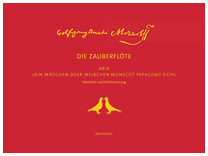|
MOZART, Wolfgang
Amadeus, 1756-1791
Die Zauberflöte
Aria: “Ein Mädchen oder
Weibchen wünscht
Papageno sich”. Faksimile und
Klavierauszug. Nachwort von Silke Leopold. [Staatsbibliothek
Preußischer Kulturbesitz, Berlin,
Mus. ms. autogr. W.A. Mozart 620].
[Magic
Flute, selection, K.620]
 first page
Kassel, 2005. Oblong, 4°, 36 pp. 4-color
halftone facsimile of the autograph score (fols.
157-160 of the opera), one of the best known arias in the history of
music. Together with
modern edition in vocal score format. The opera owes its success in no
small part to the role
of Papageno, a mixture of buffoon and harlequin, of mythical beast and
child of nature,
uniting many theatrical traditions: the wily servant and fool of the
commedia dell’arte,
Prince Tamino and his grudging servant, Papageno the Bird-Catcher, are
the same pairing
opposites as Don Giovanni and Leporello, etc. Schikaneder actually
wrote the part of the
Bird-Catcher to showcase his own talents. Mozart captures a humorous
account of a performance
of the work at the Freihaus-Theater in a letter to Constanze, dated 9
Oct. 1791: “During
Papageno’s aria with the glockenspiel I went behind the stage, as I
felt a sort of impulse
today to play it myself. Well, just for fun, at the point where
Schikaneder has a pause, I
played an arpeggio. He was startled, looked into the wings and saw me.
When he had his next
pause, I played no arpeggio. This time he stopped and refused to go on.
I guessed what he was
thinking and again played a chord. He then struck the glockenspiel and
said ‘Shut up’.
Whereupon everyone laughed. I am inclined to think that this joke
taught many of the audience
for the first time that Papageno does not play the instrument himself.”
Commentary in
Ger-Eng-Jap. With attractive binding red linen. $32
|
|
|

